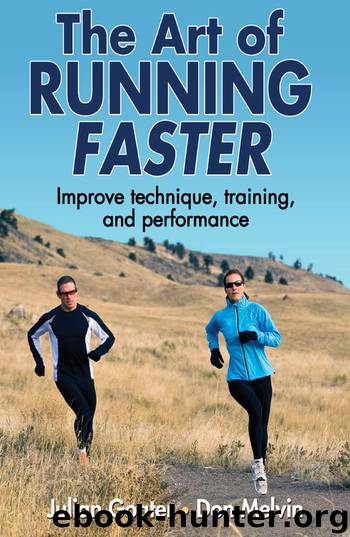The Art of Running Faster by Julian Goater

Author:Julian Goater
Language: eng
Format: epub, mobi
ISBN: 9781450419819
Publisher: Human Kinetics
VARIATIONS ON A THEME
But that overload also makes it easy to overdo it. Select the gradient, length, and surface of your hill carefully for the session you have in mind. You’ll likely want a recovery day afterwards. That means an easy run, walk, or swim, not a day doing nothing. And keep in mind that one of the goals of any training session is to leave yourself fit and ready to train again. You want to work very hard but you don’t want to become jaded. So you’ve read somewhere that the New Zealander Peter Snell ran two-minute reps up a hill with (allegedly) a gradient of one in three—which, take it from me, is quite steep. Yes, he won three Olympic golds and set five world records. But that doesn’t mean you should try the same thing. Snell was an unusually powerful runner. You need to make the sessions manageable for you.
You can run some longer hill reps, though, and they’ll benefit you if you’re trying to get ready for a longer race, like a marathon. The trouble with longer reps is that it takes so long to jog back to the bottom that you get more rest than is optimal. But there’s a way to get around that. Find a hill that’s Peter Snell’s length or even longer, and run it in segments.
Sebastian Coe, for all his exploits, was not a great cross country runner. His world records were all on the flat, of course—on the track—but he ran some serious hills on his way to setting them. Famously, he used the Rivelin Valley Road, a three-mile hill just west of Sheffield, to do long hill repeats.
One of his sessions was six times half a mile. His dad would follow him up this three-mile hill in the car, because everything was timed and measured. Seb would run 800 metres fast and then, instead of jogging back down, he’d have a timed rest right where he was, and then run another half mile up the hill, until he’d run the six half-mile efforts.
That’s a good way to approach it: Don’t think, ‘I’ve got a three-mile hill, so I’ve got to go from the bottom to the top all in one go.’ You can be a little more imaginative, and come up with a pattern that suits your abilities and requirements.
Download
This site does not store any files on its server. We only index and link to content provided by other sites. Please contact the content providers to delete copyright contents if any and email us, we'll remove relevant links or contents immediately.
| Cricket | Field Hockey |
| Lacrosse | Rugby |
| Track & Field | Volleyball |
Going Long by Editors of Runner's World(2213)
The Happy Runner by David Roche(2122)
Yoga For Dummies by Georg Feuerstein(1382)
Becoming Boston Strong by Amy Noelle Roe(1260)
Legacy by Kerr James(1235)
Winger by Smith Andrew(1186)
The Little Red Book of Running by Scott Douglas(1114)
Wodehouse At the Wicket by P.G. Wodehouse(1055)
Bowerman and the Men of Oregon by Kenny Moore(1054)
The Way of the Runner by Adharanand Finn(1034)
5050 by Dean Karnazes(1016)
Running Your First Marathon by Andrew Kastor(999)
Swim, Bike, Run - Eat by Tom Holland(986)
The Coming Storm by Nigel McCrery(954)
Blade Runner by Oscar Pistorius(948)
Spiked (Blocked Book 3) by Jennifer Lane(944)
The Grade Cricketer by Dave Edwards(918)
The Shared Origins of Football, Rugby, and Soccer by Christopher Rowley(913)
The Amazing Test Match Crime by Adrian Alington(904)
